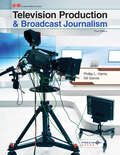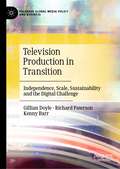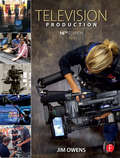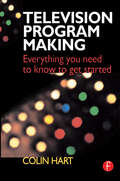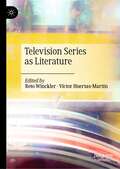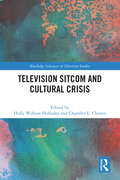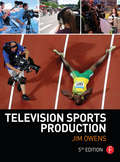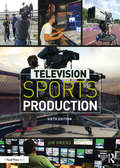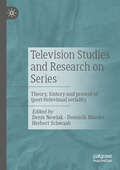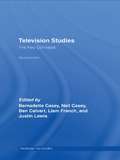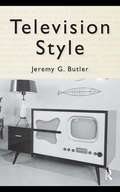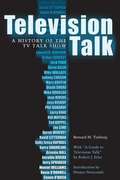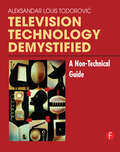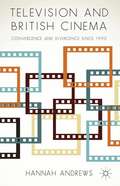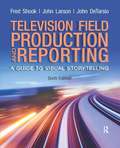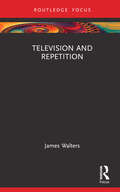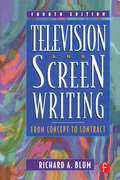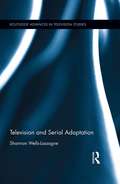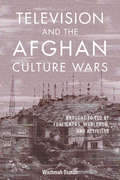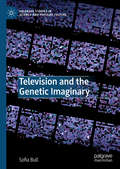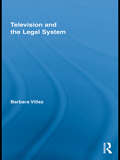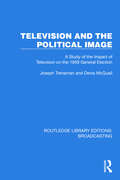- Table View
- List View
Television Production and Broadcast Journalism
by Phillip L. Harris Gil GarciaTelevision Production & Broadcast Journalism provides students with basic technical skills necessary to enter the television production industry as a production assistant, and introduces broadcast journalism theory. The text provides an overview of the equipment, job responsibilities, and techniques involved in both traditional studio production and remote location work. The activities and processes involved in each phase of production are presented and reinforced with realistic examples, numerous photos showing students in actual production situations, and engaging student activities. <p><p>Broadcast journalism coverage includes ethics and news judgment, types of stories, news writing, preparing news packages, and conducting interviews. The broadcast journalism topics address skills and qualities required in the industry, but also incorporate classroom-appropriate standards and practices.
Television Production in Transition: Independence, Scale, Sustainability and the Digital Challenge (Palgrave Global Media Policy and Business)
by Gillian Doyle Richard Paterson Kenny BarrFocusing on the growing power of transnational media corporations in an increasingly globalized environment for distribution of television content, and on the effects of mergers and acquisitions involving local and independent television production companies, this book examines how current and recent re-structurings in ownership across the television industry reflect changing business models, how they affect creativity and diversity of television output, and to what extent they call for new approaches to regulation and policy. Based on a major study of the UK production sector as a case study, it offers a unique analysis of wider transformations in ownership affecting the television production industry worldwide and of their economic, socio-cultural and policy implications.
Television Production, 16th Ed.
by Jim OwensGain the skills you need to succeed in the television industry and master the production process, from shooting and producing, to editing and distribution. This new and updated 16th edition of Television Production offers a thorough and practical guide to professional TV and video production techniques. You will learn how to anticipate and quickly overcome commonly-encountered problems in television production, as Jim Owens details all the major features of television production, including the secrets of top-grade camerawork, persuasive lighting techniques, effective sound treatment, as well as the subtle processes of scenic design, and the art of video editing. The 16th edition of this classic text now explores the changing television landscape, the effects of the "second screen" on viewer experience, 4K and 8K shooting and the real implications it has for your production, and much more. This new edition also includes:<P><P> * Discussions on the changing definition of "television" and how new technology effects veiwers and their viewing habits<P> * Updated interviews with professionals in the industry, such as noted documentary filmmaker, Sarah Leckie, about the challenges they face during the production process and the advice they would give to those trying to break in to the production and television industries<P> * Thorough definitions of television and production terminology as well as information on LED lighting and other technologies used on set<P> * A comprehensive resource page for instructors, containing slides and testing materials to aid in the learning process can be found at www.focalpress.com/cw/owens.
Television Program Making: Everything you need to know to get started
by Colin HartThis book is for anyone starting out or hoping to work in the ever-expanding world of television and video. Everyone involved in a TV or video production is contributing to the program making process. They all need to know and understand how it happens. Whatever you want to end up doing, whether you are part way through a course or starting from scratch, this book gives you all the essential information you will need. It takes a practical, step-by-step approach, based on the author's own 25-year experience of producing, writing and directing for broadcast television and the corporate sector on both video and film. It describes the roles people perform, the equipment they use and what it does. In simple, easy-to-read language it explains the grammar of shooting and editing and offers first-hand advice on treatments, scripts and budgets. As well as covering the technical aspects of both single and multi-camera production, it also looks at the editorial elements that create a successful program. With practical examples it demonstrates how best to turn ideas into reality, how to obtain successful interviews and how to put together programs that work. Colin Hart has his own production company making programs for corporate clients. He trained as a single and multi-camera director in local televison news and for ten years worked in BBC Current Affairs producing and directing for Nationwide and The Money Programme.
Television Publics in South Asia: Mediated Politics and Culture
by S.M. Shameem Reza and Ratan Kumar RoyTelevision has a prime role to play in the formation of discursive domains in the everyday life of South Asian publics. This book explores various television media practices, social processes, mediated political experiences and everyday cultural compositions from Afghanistan, Bangladesh, India, Nepal, Pakistan and Sri Lanka. With the help of country specific case studies, it captures broad range of themes which foreground the publics and their real-life experiences of television in the region. The essays in this book discuss gendered television spaces; women seeking solace from television in pandemic; the taboo in digital tv dramas; television viewership and localizing publics; changing viewership from television to OTT; news and public perception of death; re-defining ‘the national’; theatrical television; and post truth television news, among other key issues. Rich in ethnographic case studies, this volume will be a useful resource for scholars and researchers of media and communication studies, journalism, digital media, South Asian studies, cultural studies, sociology and social anthropology.
Television Series as Literature
by Reto Winckler Víctor Huertas-MartínThis book explores how television series can be understood as a form of literature, bridging the gap between literary and television studies. It goes beyond existing adaptation studies and narratological approaches to television series in both its scope and depth. The respective chapters address literary works, themes, tropes, techniques, values, genres, and movements in relation to a broad variety of television series, while drawing on the theoretical work of a host of scholars from Simone de Beauvoir and Yuri Lotman to Ted Nannicelli and Jason Mittel, and on critical approaches ranging from narratology and semiotics to empirical sociology and phenomenology. The book fosters new ways of understanding television series and literature and lays the groundwork for future scholarship in a number of fields. By questioning the alleged divide between television series and works of literature, it contributes not only to a better understanding of television series and literary texts themselves, but also to the development of interdisciplinary scholarship in the humanities.
Television Sitcom and Cultural Crisis (Routledge Advances in Television Studies)
by Holly Willson Holladay Chandler L. ClassenThis volume demonstrates that television comedies are conduits through which we might resist normative ways of thinking about cultural crises.By drawing on Gramscian notion of crisis and the understanding that crises are overlapping, interconnected, and mutually constitutive, the essays in this collection demonstrate that situation comedies do more than make us laugh; they also help us understand the complexities of our social world’s moments of crisis. Each chapter takes up the televisual representation of a modern cultural crisis in a contemporary sitcom and is grounded in the extensive body of literature that suggests that levity is a powerful mechanism to make sense of and cope with these difficult cultural experiences.Divided into thematic sections that highlight crises of institutions and systems, identity and representation, and speculation and futurism, this book will interest scholars of media and cultural studies, political economy, communication studies, and humor studies.
Television Sports Production
by Jim OwensUnlike a studio production, many factors can adversely affect your television sports shoot including weather, lighting, and natural sound. A successful shoot is dependent on extensive planning, careful budgetting, technology, location, and a thorough understanding of the intricacies of the sport itself. With so much at stake, why not learn from an expert? In Television Sports Production, Fifth Edition Jim Owens walks you through the planning, set-up, directing, announcing, shooting, and editing involved with covering a sports event. This manual gives you the tools to effectively cover sports ranging such as football, soccer, and basketball. Tips and advice on using mobile units, cameras, audio equipment, and lighting rigs will enable you to produce live or recorded coverage like an expert and capture professional-quality footage on the first take. After all, there are no instant replays! This new edition has been updated to include: Techniques used by producers to capture the essence of individual Tips on shooting in 3D, 5D, 4k and 8K Coverage using surround sound and the second screen Extras such as camera and microphone diagrams and an easy-reference glossary
Television Sports Production
by Jim OwensIn this sixth edition of Television Sports Production, regional Emmy Award-winning producer Jim Owens walks readers through the planning, setup, directing, announcing, shooting, and editing involved in covering a sports event. Originally written as a training guide for entry-level broadcast staff at the Olympics, this manual gives readers the tools they need to effectively cover sports from ice skating to motorcycle racing. Throughout, Owens breaks down all aspects of the production process, revealing the techniques that producers and directors use to bring sports to a worldwide audience. Chapters further include tips and advice on using the latest technologies and tools such as production trucks, REMIs, smart phones, mobile units, cameras, audio equipment, and lighting rigs. Featuring new instructive illustrations and sample forms, as well as testimonials from experienced professionals in the business, this new edition gives readers an inside look at how the experts produce live or recorded television and sports coverage. This comprehensive book is essential reading for intermediate and advanced students looking to learn how to successfully produce sports broadcasting.
Television Studies and Research on Series: Theory, history and present of (post-)televisual seriality
by Dominik Maeder Denis Newiak Herbert SchwaabTelevision series enjoy an unbroken - popular as well as scholarly - attention. It is surprising, however, that in works on seriality in media and cultural studies, approaches to television studies and television history still play a rather minor role. Yet seriality should always be thought of in terms of television, since the two have always been inextricably interwoven - economically, technically and aesthetically. But what else constitutes the serial in television and how does it change its face in times of digitalization, streaming and interactivity? Is it possible to think of a genuine serial theory of the televisual - and what, in turn, can be learned from this for seriality beyond television? The essays in this volume contribute to shedding new light on the serial as a core principle of television and to providing new impulses for a television theory of the serial on the basis of diverse examples from the current range of television series.
Television Studies: The Basics (The Basics)
by Toby MillerTelevision Studies: The Basics is a lively introduction to the study of a powerful medium. It examines the major theories and debates surrounding production and reception over the years and considers both the role and future of television. Topics covered include: broadcasting history and technology institutions and ownership genre and content audiences Complete with global case studies, questions for discussion, and suggestions for further reading, this is an invaluable and engaging resource for those interested in how to study television.
Television Studies: The Key Concepts (Routledge Key Guides)
by Justin Lewis Neil Casey Ben Calvert Bernadette Casey Liam FrenchTelevision Studies: The Key Concepts is the definitive reference guide to an area of rapidly expanding academic interest. Among those aspects of television studies covered in this comprehensive and up-to-date guide are: theoretical perspectives which have shaped the study of television - Marxism; semiology; feminism concepts which have shaped the study of television - narrative; representation; bias television genres - soap opera; news; science fiction methods used for understanding television - content analysis; audience research relevant social, economic and political phenomena - ownership; social policy.
Television Style
by Jeremy G. ButlerStyle matters. Television relies on style—setting, lighting, videography, editing, and so on—to set moods, hail viewers, construct meanings, build narratives, sell products, and shape information. Yet, to date, style has been the most understudied aspect of the medium. In this book, Jeremy G. Butler examines the meanings behind television’s stylstic conventions. Television Style dissects how style signifies and what significance it has had in specific television contexts. Using hundreds of frame captures from television programs, Television Style dares to look closely at television. Miami Vice, ER, soap operas, sitcoms, and commercials, among other prototypical television texts, are deconstructed in an attempt to understand how style functions in television. Television Style also assays the state of style during an era of media convergence and the ostensible demise of network television. This book is a much needed introduction to television style, and essential reading at a moment when the medium is undergoing radical transformation, perhaps even a stylistic renaissance. Discover additional examples and resources on the companion website: www.tvstylebook.com.
Television Talk: A History of the TV Talk Show
by Bernard M. TimbergFlip through the channels at any hour of the day or night, and a television talk show is almost certainly on. Whether it offers late-night entertainment with David Letterman, share-your-pain empathy with Oprah Winfrey, trash talk with Jerry Springer, or intellectual give-and-take with Bill Moyers, the talk show is one of television's most popular and enduring formats, with a history as old as the medium itself.
Television Technology Demystified: A Non-technical Guide
by Aleksandar Louis Todorovic"Television Technology Demystified" is written for non-technical television production professionals. Journalists, program producers, camera persons, editors, and other television professionals need to know how equipment works, which performance levels are achievable, how to evaluate the technical quality of picture and sound, and other aspects of production; this book presents these and other essential concepts in a simple and non-mathematical way. Aleksandar-Louis Todorovic, a highly respected and well-known figure in the broadcasting community, has succeeded in making complex technology understandable.
Television and British Cinema
by Hannah AndrewsUndertaking a thorough and timely investigation of the relationship between television and cinema in Britain since 1990, Hannah Andrews explores the convergence between the two forms, at industrial, cultural and intermedial levels, and the ways in which the media have also been distinguished from one another through discourse and presentation.
Television and Field Reporting (Sixth Edition)
by Fred Shook John Larson John DetarsioUpdated in its 6th edition, Television Field Production and Reporting provides an exciting introduction to the art of visual storytelling. Endorsed by the National Press Photographers Association, it focuses on the many techniques and tools available in television today.
Television and Repetition
by James WaltersResisting some of the negative connotations that repetition can attract, this book illustrates how it has been used as a catalyst for creative expression across a range of television genres. Divided into two parts, the first three chapters contextualise repetition within related media and critical debates, before locating it as an important facet of television that is worth exploring in detail. The final three chapters discuss specific television shows that incorporate repetition creatively within their narrative structure and aesthetic composition, ranging from The Royle Family and Doctor Who to I May Destroy You and This is Going to Hurt. In each case, James Walters argues that repetition emerges as crucial to the expression of key themes and ideas, thus becoming a structural and compositional element itself. Exploring the ways in which repetition has featured in the work of figures such as Umberto Eco, Raymond Bellour and Bruce Kawin, and has influenced the approaches of television scholars like Raymond Williams, Roger Silverstone and John Ellis, this book is essential reading for scholars and students of film, television and media studies.
Television and Screen Writing: From Concept to Contract
by Richard A BlumNow in its fourth edition, Television and Screen Writing: From Concept to Contract is a classic resource for students and professionals in screenwriting and television writing. This book will teach you how to become a creative and marketable writer in every professional arena - including major studios, production companies, networks, cable and pay TV, animation, and interactive programs. Specific techniques and script samples for writing high-quality and producible "spec" scripts for theatrical motion pictures, the sitcom series, one-hour dramatic series, longform television, soaps, talk show, variety, animation, interactive and new media are provided. Television and Screen Writing: From Concept to Contract, Fourth Edition also offers a fully detailed examination of the current marketplace, and distinct strategies for marketing your scripts, from registering and copyrighting the script to signing with an agent. This new edition has been expanded to include the most up-to-date creative and professional script samples, marketing resources, and practical information possible. The companion website (www.focalpress.com/companions) offers a wide range of contacts and resources for you to explore, and Internet links to professional resources. There is also an Annotated and Selected Bibliography for your reference
Television and Serial Adaptation (Routledge Advances in Television Studies)
by Shannon Wells-LassagneAs American television continues to garner considerable esteem, rivalling the seventh art in its "cinematic" aesthetics and the complexity of its narratives, one aspect of its development has been relatively unexamined. While film has long acknowledged its tendency to adapt, an ability that contributed to its status as narrative art (capable of translating canonical texts onto the screen), television adaptations have seemingly been relegated to the miniseries or classic serial. From remakes and reboots to transmedia storytelling, loose adaptations or adaptations which last but a single episode, the recycling of pre-existing narrative is a practice that is just as common in television as in film, and this text seeks to rectify that oversight, examining series from M*A*S*H to Game of Thrones, Pride and Prejudice to Castle.
Television and the Afghan Culture Wars: Brought to You by Foreigners, Warlords, and Activists (The Geopolitics of Information #12)
by Wazhmah OsmanPortrayed in Western discourse as tribal and traditional, Afghans have in fact intensely debated women's rights, democracy, modernity, and Islam as part of their nation building in the post-9/11 era. Wazhmah Osman places television at the heart of these public and politically charged clashes while revealing how the medium also provides war-weary Afghans with a semblance of open discussion and healing. After four decades of gender and sectarian violence, she argues, the internationally funded media sector has the potential to bring about justice, national integration, and peace. Fieldwork from across Afghanistan allowed Osman to record the voices of many Afghan media producers and people. Afghans offer their own seldom-heard views on the country's cultural progress and belief systems, their understandings of themselves, and the role of international interventions. Osman analyzes the impact of transnational media and foreign funding while keeping the focus on local cultural contestations, productions, and social movements. As a result, she redirects the global dialogue about Afghanistan to Afghans and challenges top-down narratives of humanitarian development.
Television and the Embodied Viewer: Affect and Meaning in the Digital Age (Routledge Advances in Television Studies)
by Marsha F. CassidyTelevision and the Sensate Body in the Digital Age appraises the medium’s capacity to evoke sensations and bodily feelings in the viewer. Presenting a fresh approach to television studies, the book examines the sensate force of onscreen bodies and illustrates how TV’s multisensory appeal builds viewer empathy and animates meaning. The book draws extensively upon interpretive viewpoints in the humanities to shed light on a range of provocative television works, notably The Americans, Mad Men, Little Women: LA, and Six Feet Under, with emphasis on the dramatization of gender, disability, sex, childbearing, and death. Advocating a biocultural approach that takes into account the mind sciences, Cassidy argues that interpretive meanings, shaped within today’s dynamic cultural matrix, are amplified by somatic experience. At a time when questions of embodiment and affect are crossing disciplines, this book will appeal to scholars and students working in the fields of television, film, and media studies, both in the humanities and cognitive traditions.
Television and the Genetic Imaginary (Palgrave Studies in Science and Popular Culture)
by Sofia BullThis book examines the complex ways in which television articulates ideas about DNA in the early 21st century. Considering television’s distinct aesthetic and narrative forms, as well as its specific cultural roles, it identifies TV as a key site for the genetic imaginary. The book addresses the key themes of complexity and kinship, which function as nodes around which older essentialist notions about the human genome clash with newly emergent post-genomic sensibilities. Analysing a wide range of US and UK programmes, from science documentaries, science fiction serials and crime procedurals, to family history programmes, sitcoms and reality shows, Television and the Genetic Imaginary illustrates the extent to which molecular frameworks of understanding now permeate popular culture.
Television and the Legal System (Routledge Studies in Law, Society and Popular Culture)
by Barbara VillezThis book examines the American television legal series from its development as a genre in the 1940s to the present day. Villez demonstrates how the genre has been a rich source of legal information and understanding for Americans. These series have both informed and put myths in place about the legal system in the US. Villez also contrasts the US to France, which has seen a similar interest in legal series during this period. However, French television representations of justice are strikingly different, as is the role of fiction in offering viewers the possibility of acquiring significant understandings of their legal system. The book will be an important addition to the study of popular culture and law and will interest legal scholars, sociologists, and media scholars.
Television and the Political Image: A Study of the Impact of Television on the 1959 General Election (Routledge Library Editions: Broadcasting #36)
by Denis McQuail Joseph TrenamanWas the 1959 UK General Election the first television election? Could television be used to create a Party ‘image’? Television and the Political Image (1961) provides answers to both these questions. It surveys two constituencies, interviewing the same cross-section of electors before and after the election campaign, and analyses and compares the campaigns as conducted by television, radio, the Press, and through the work of the local Parties. Various effects of the political barrage are measured and attributed to their sources; such effects include changes in voting intention during the course of the election campaign, changes in attitudes to Parties and their leaders, and changes in what the voter knows of the parties’ policies.
